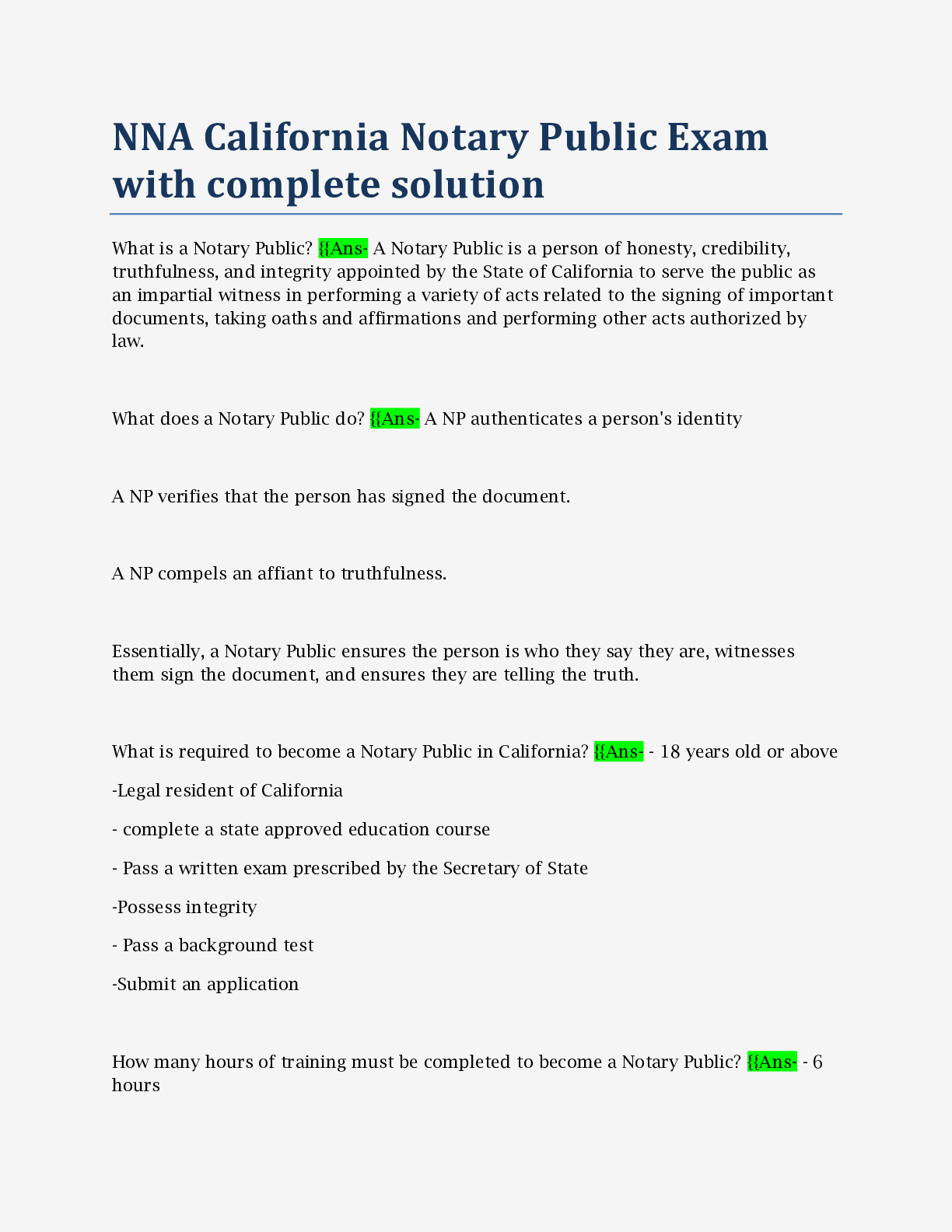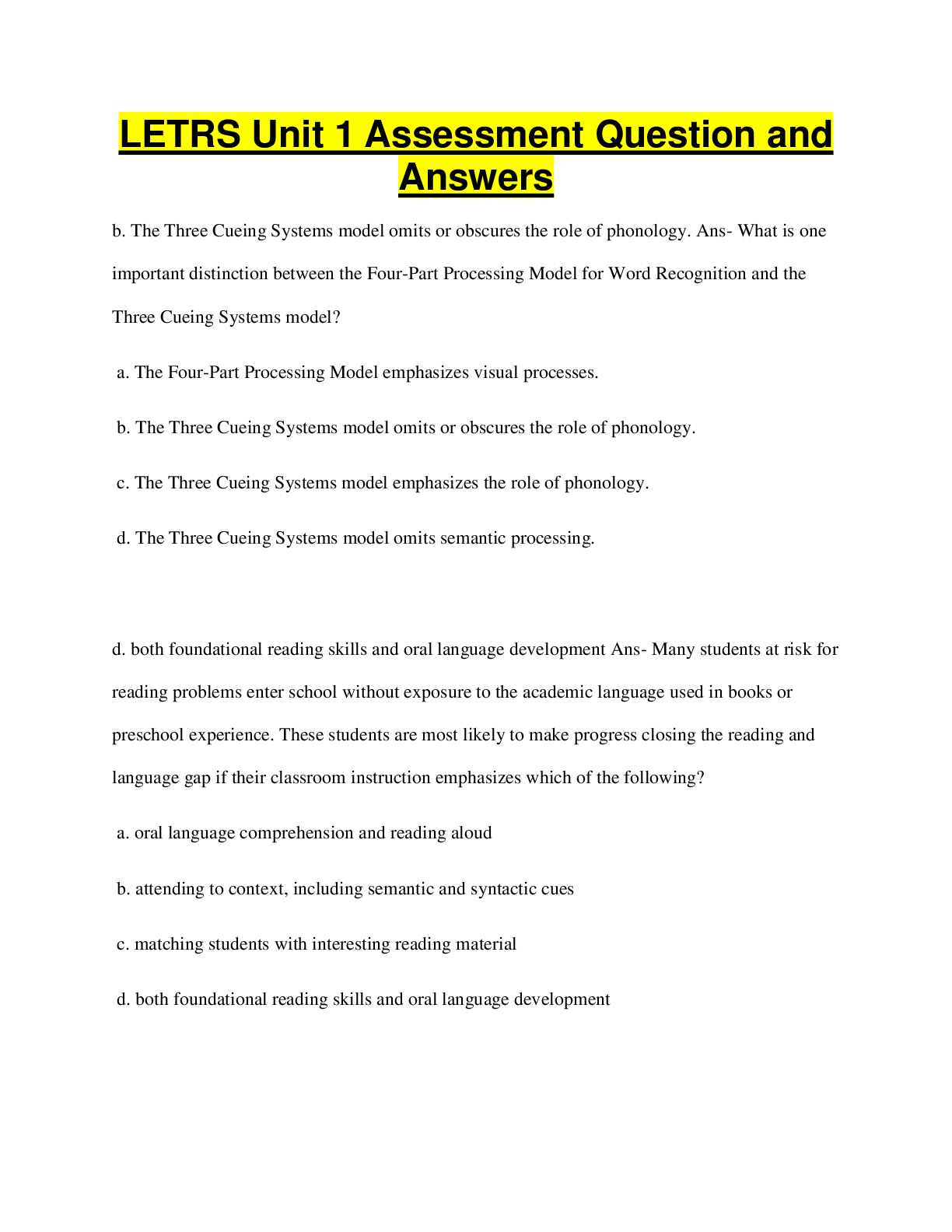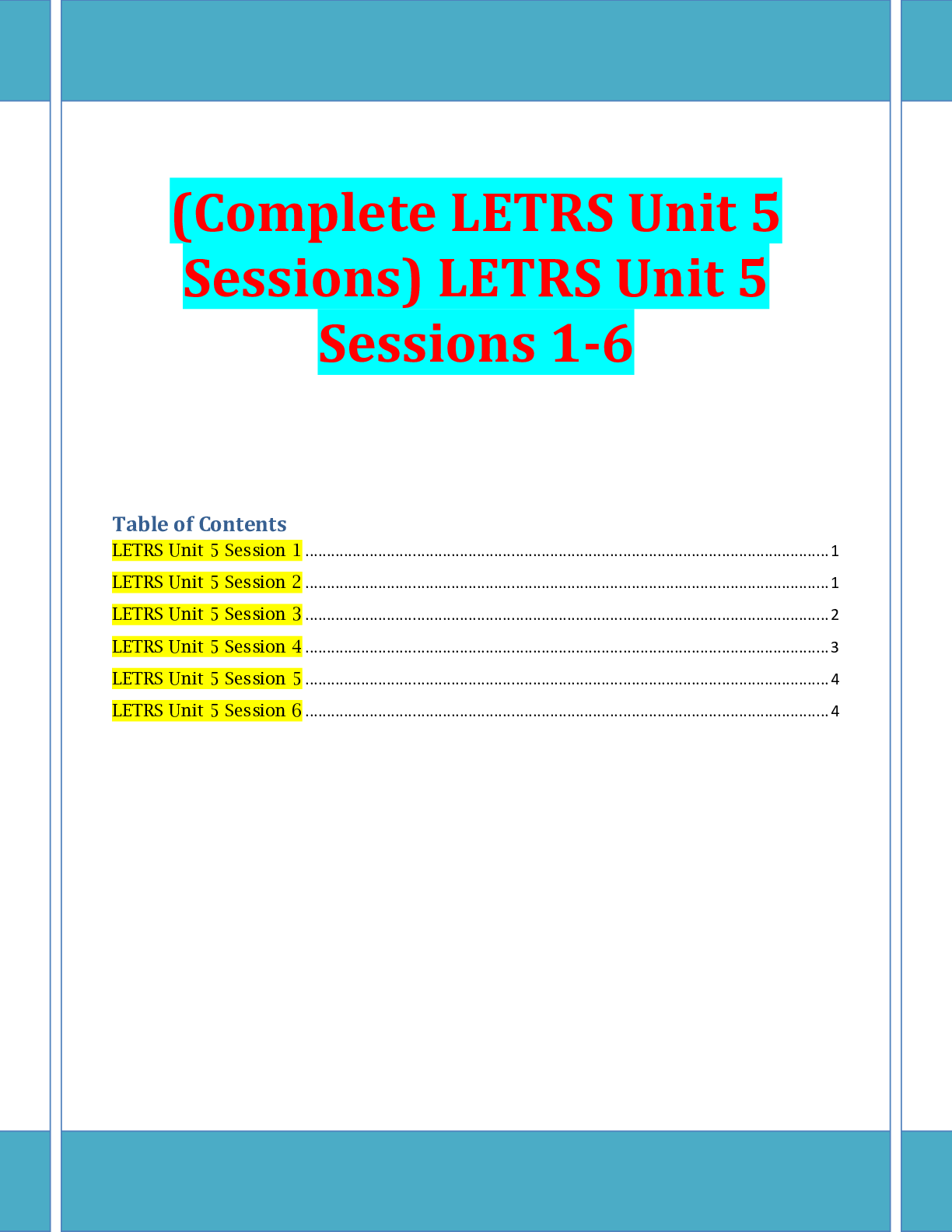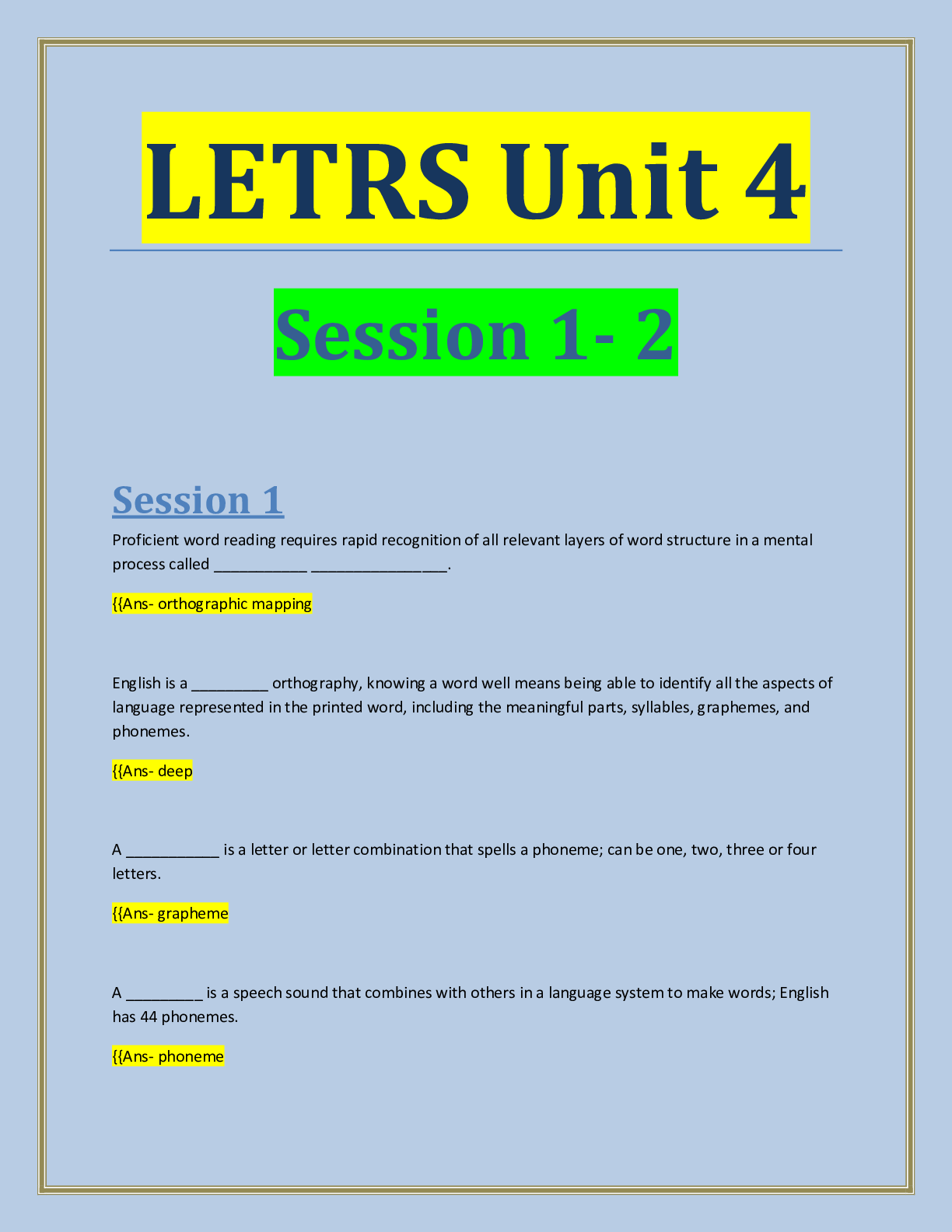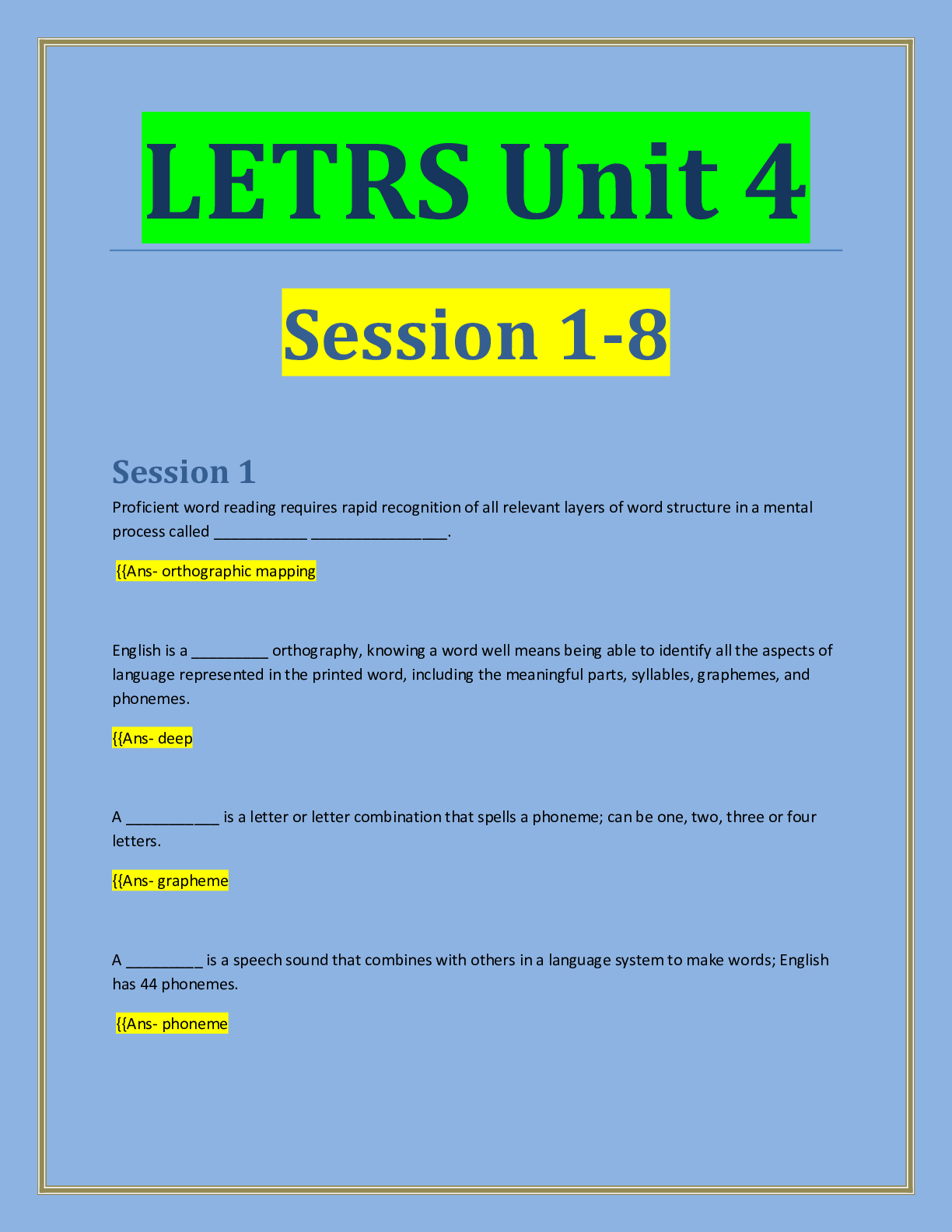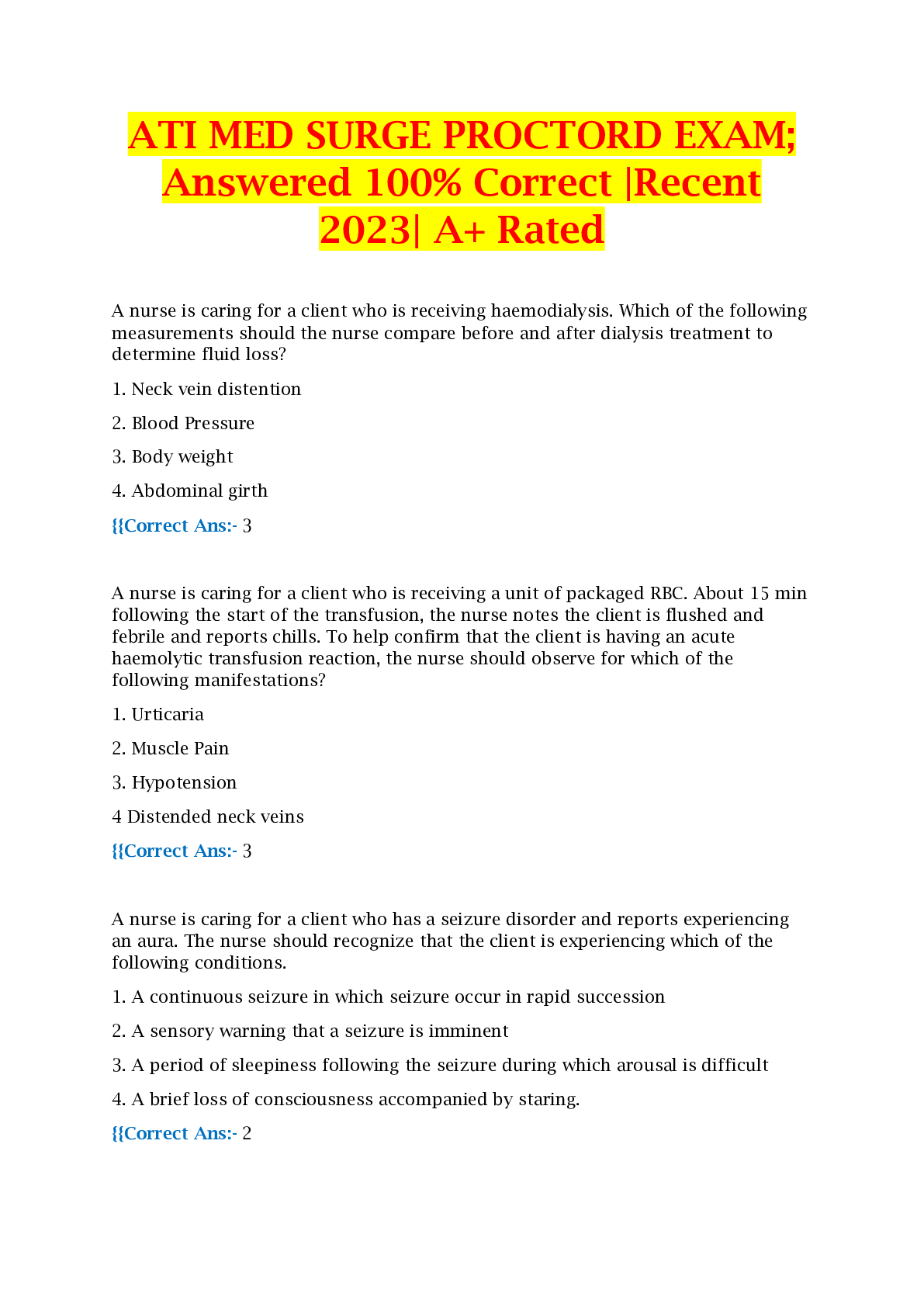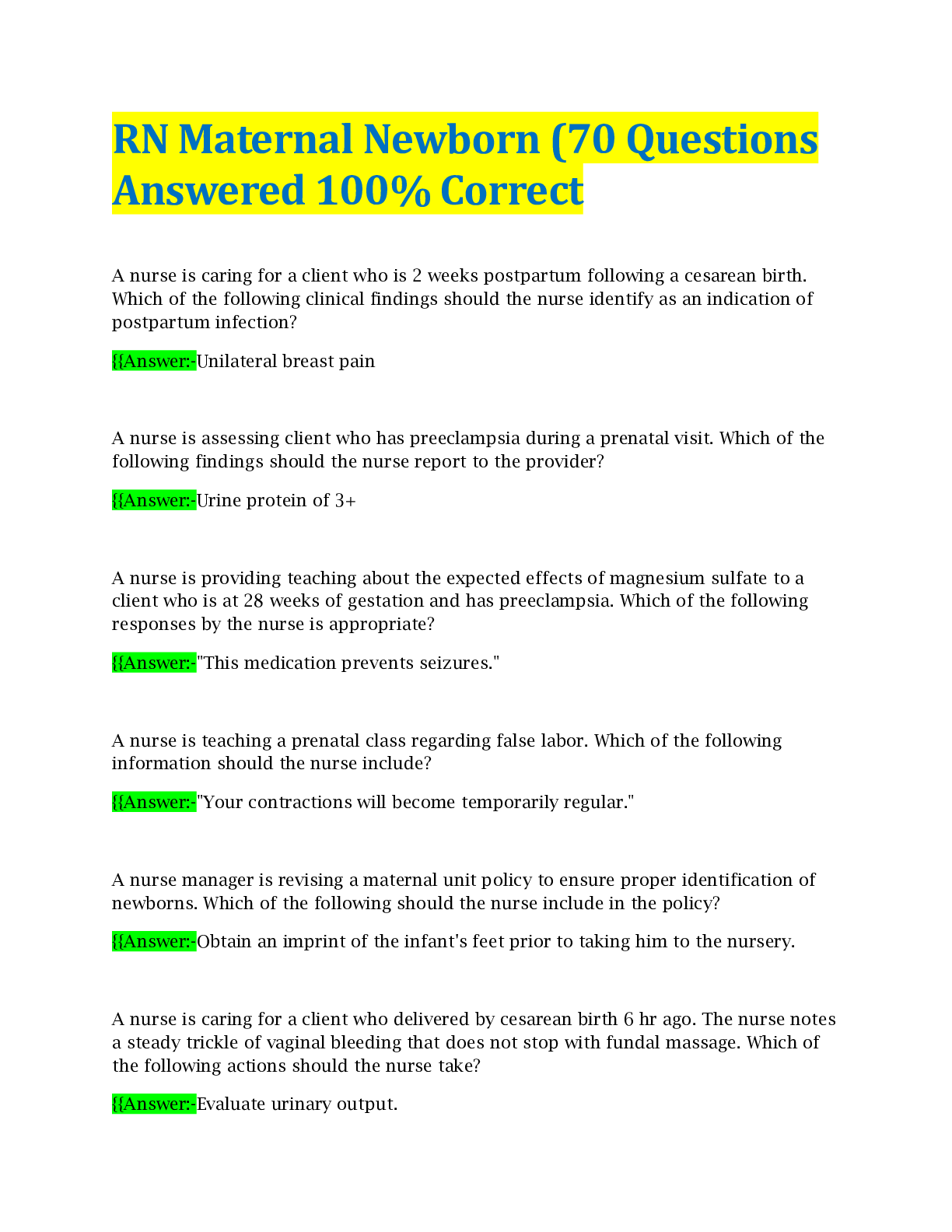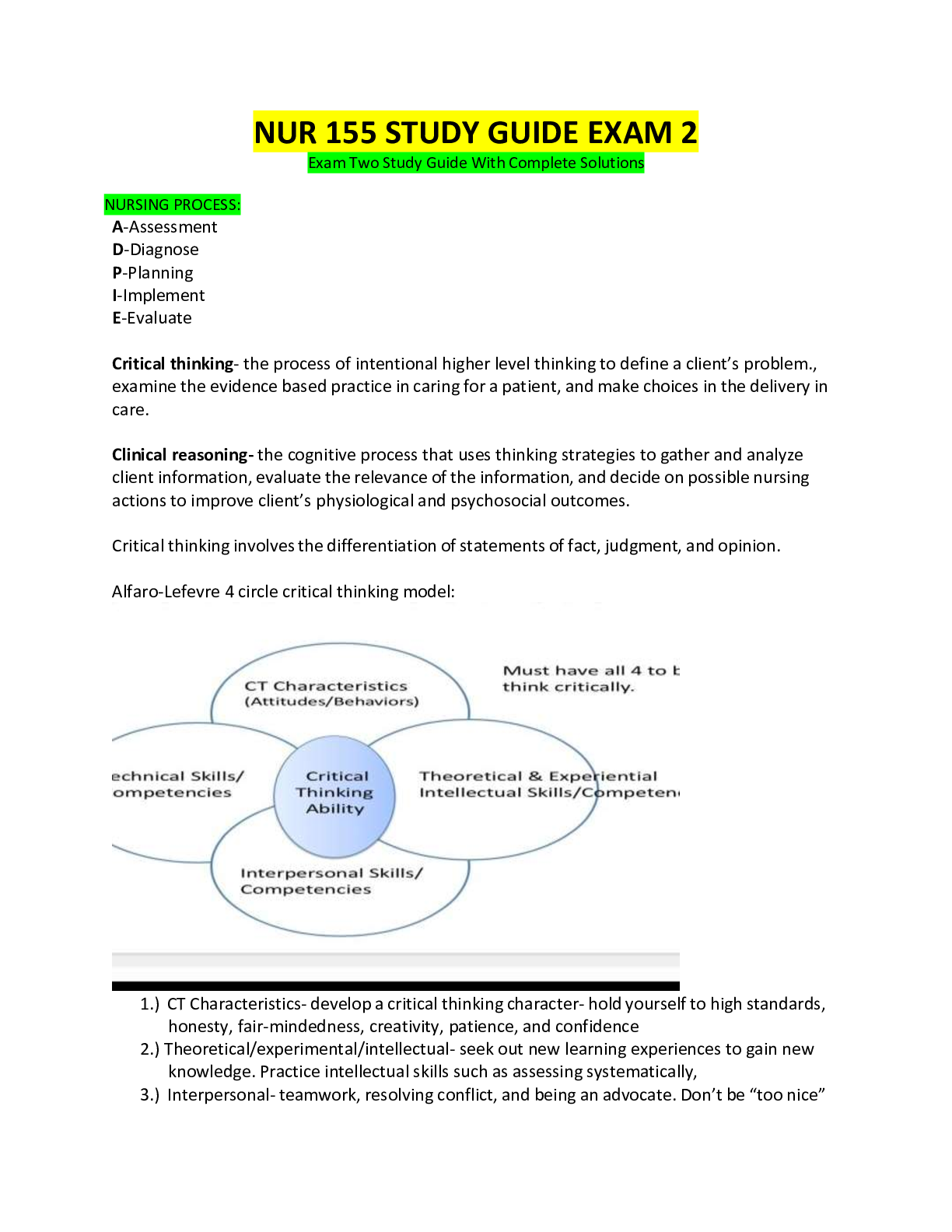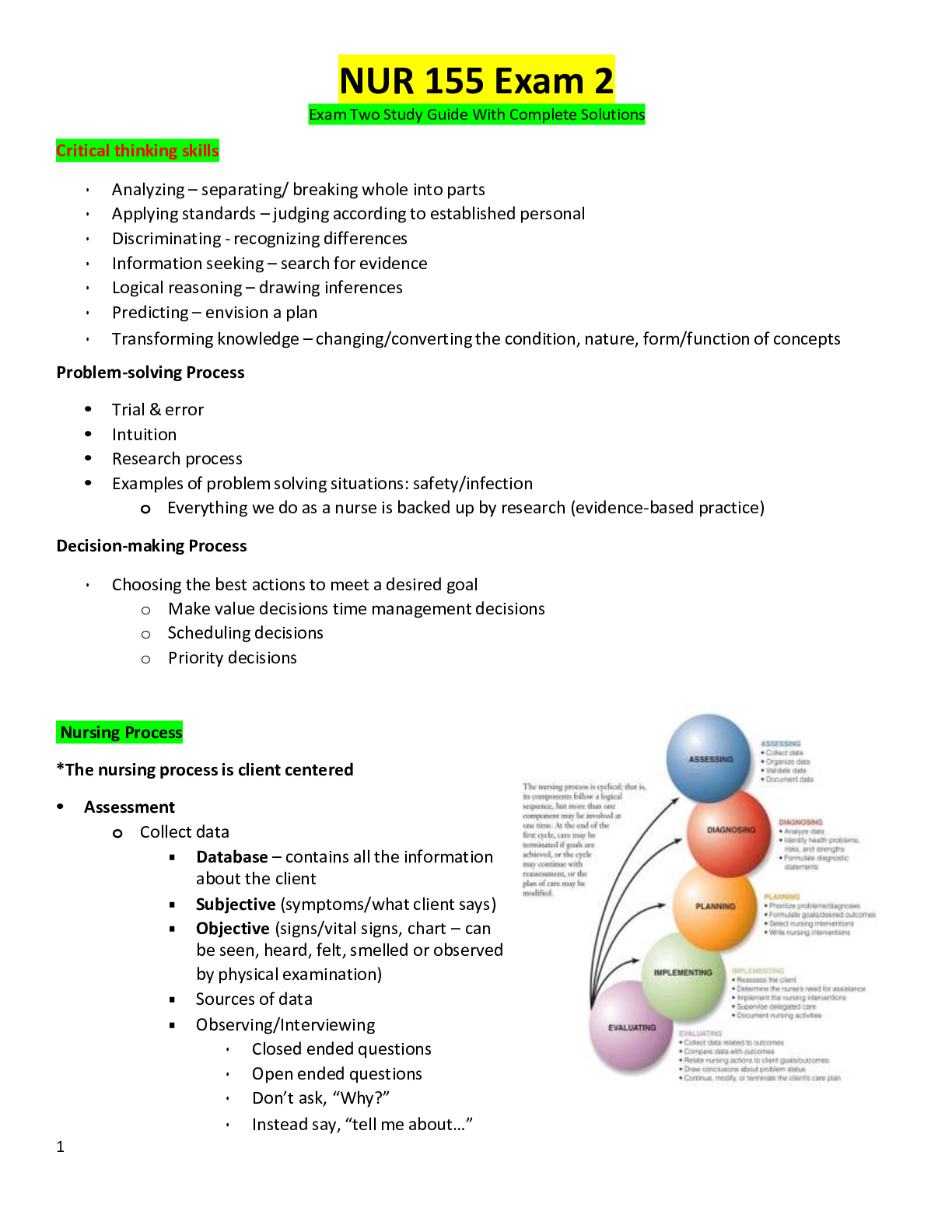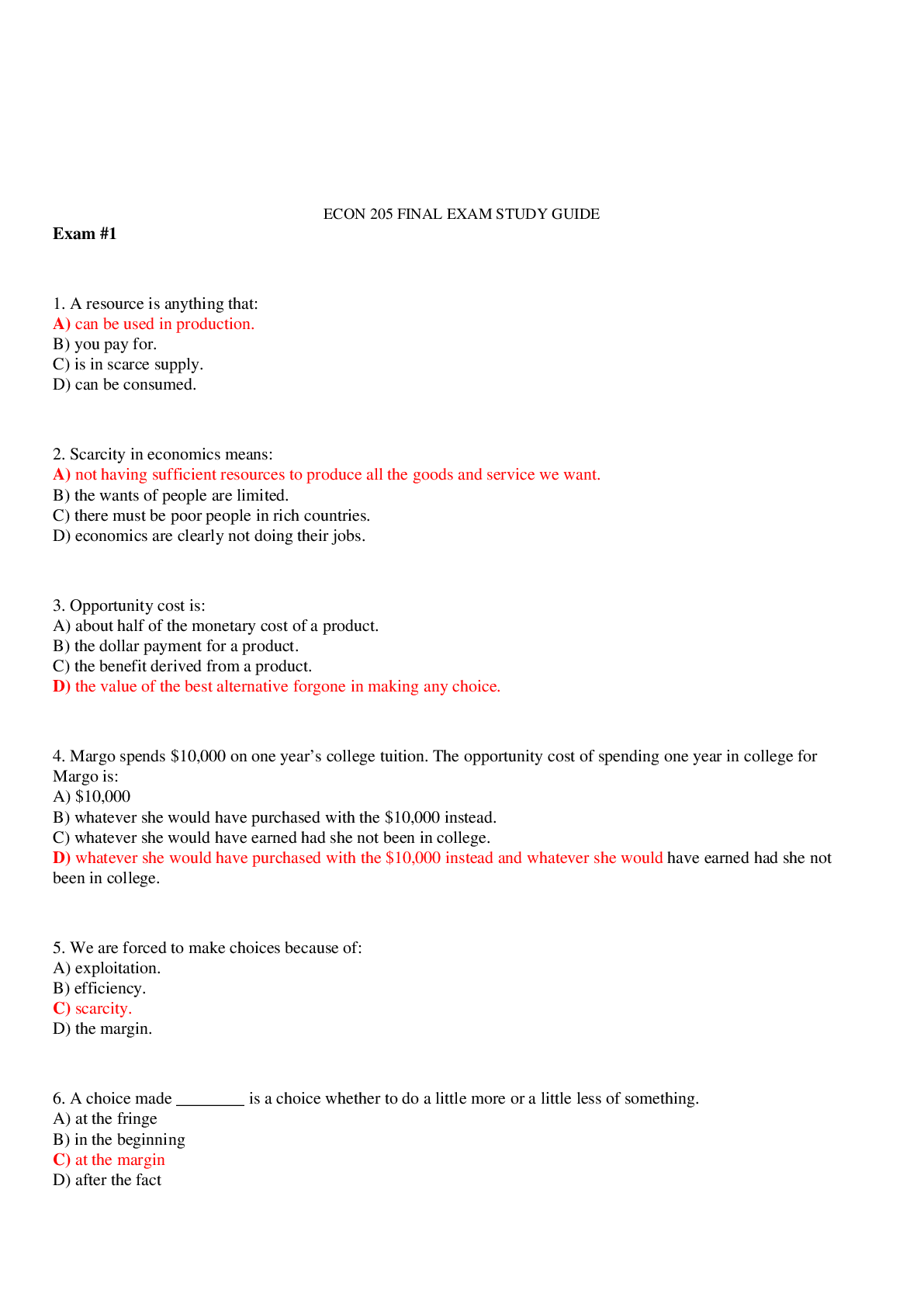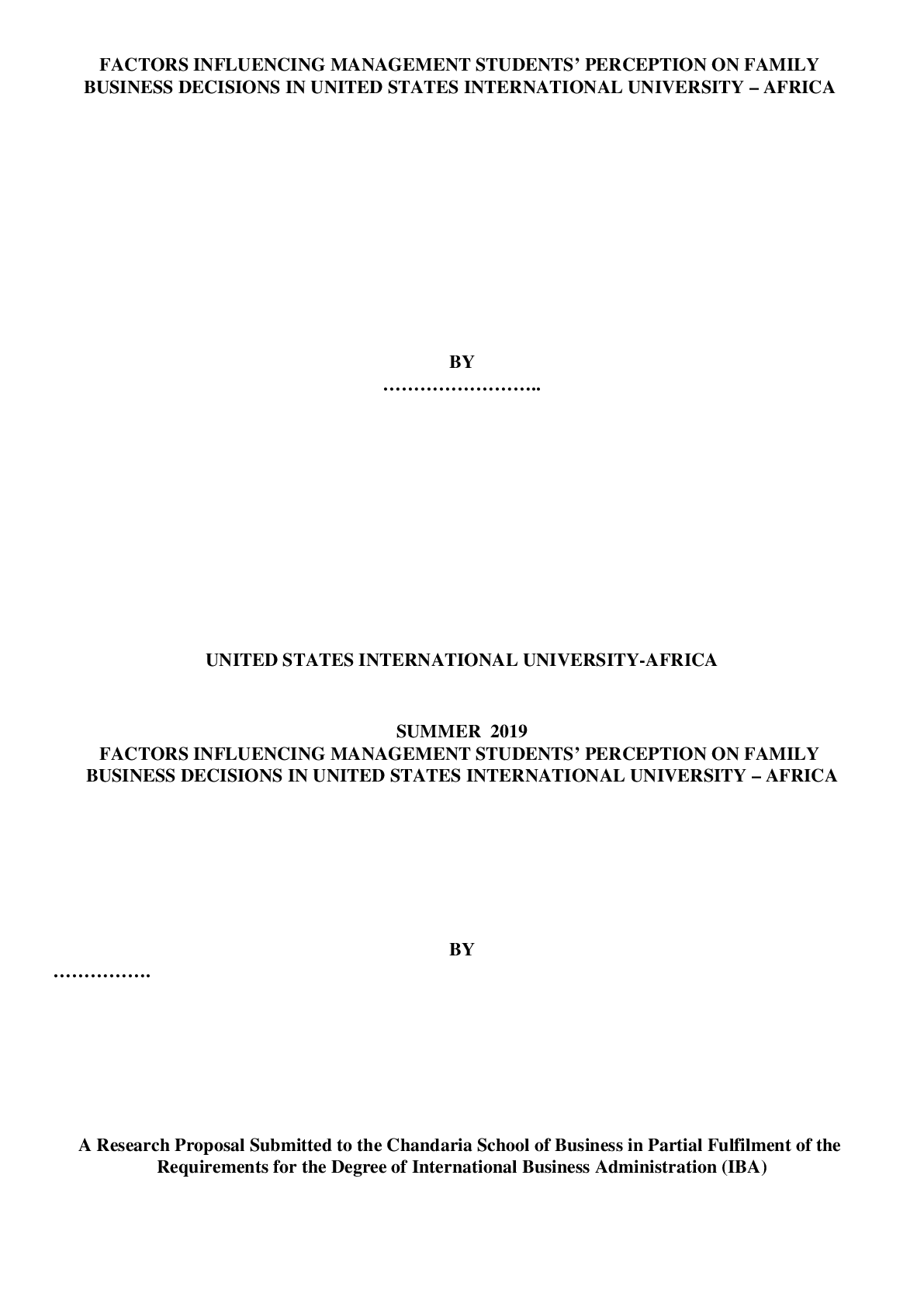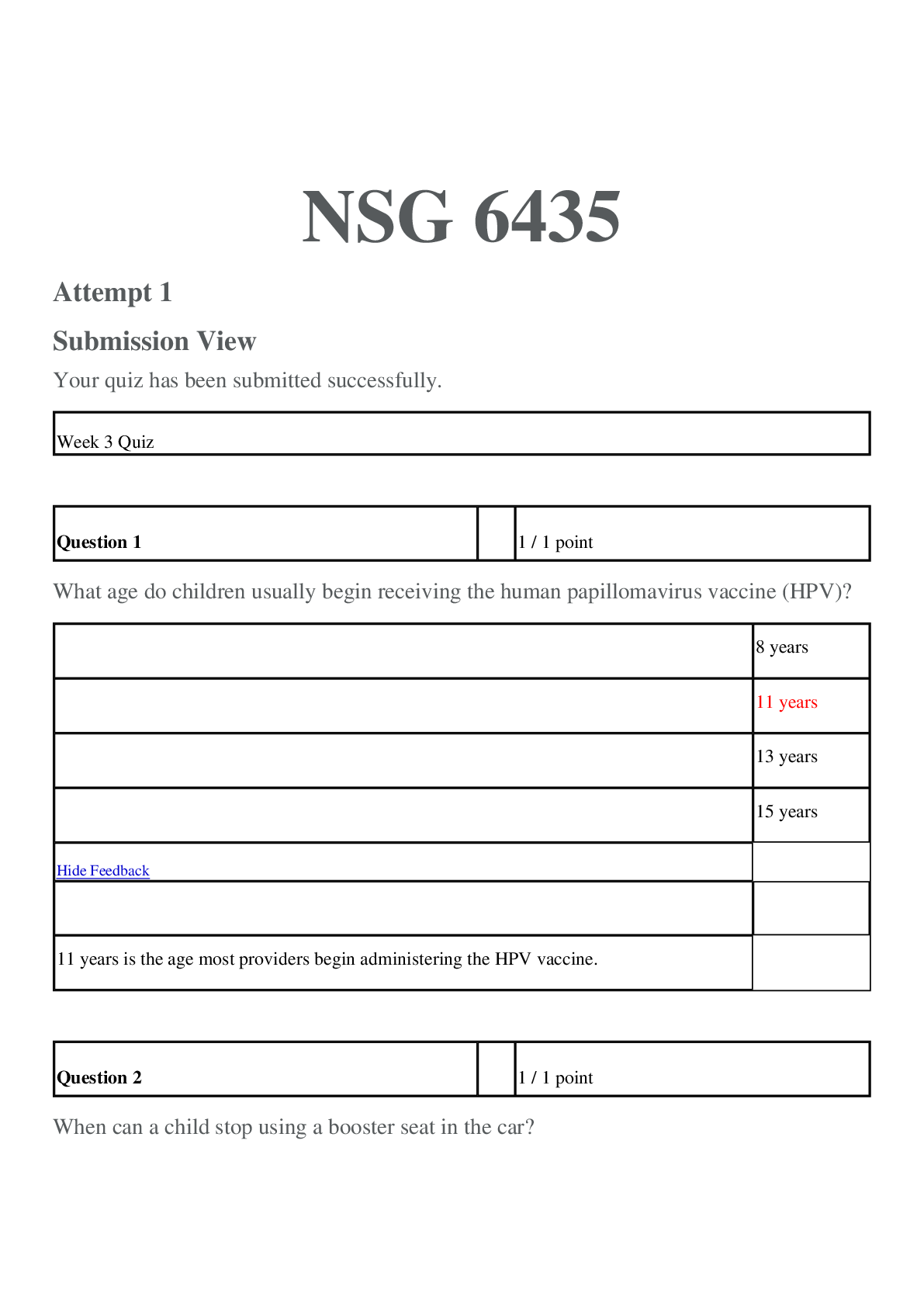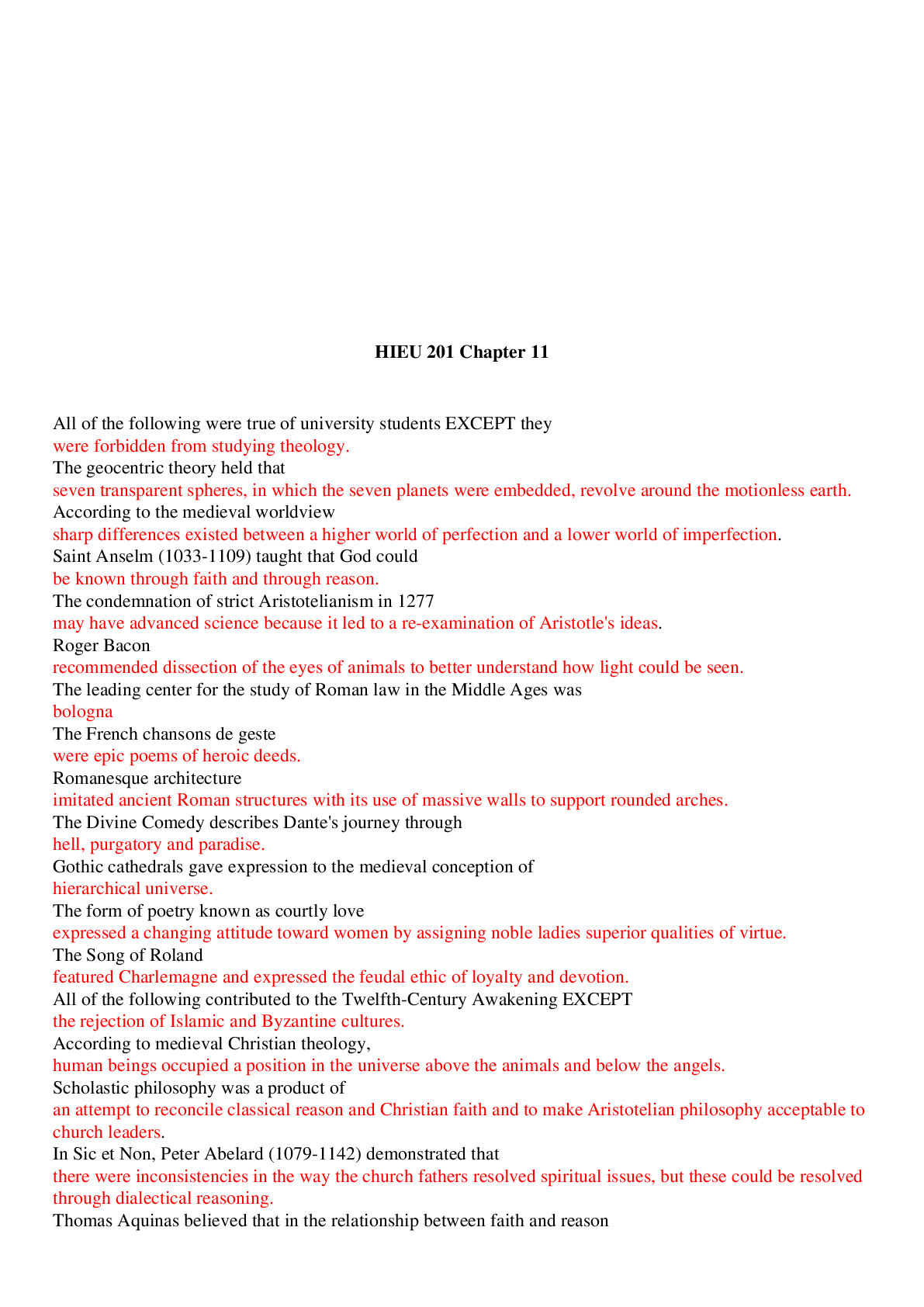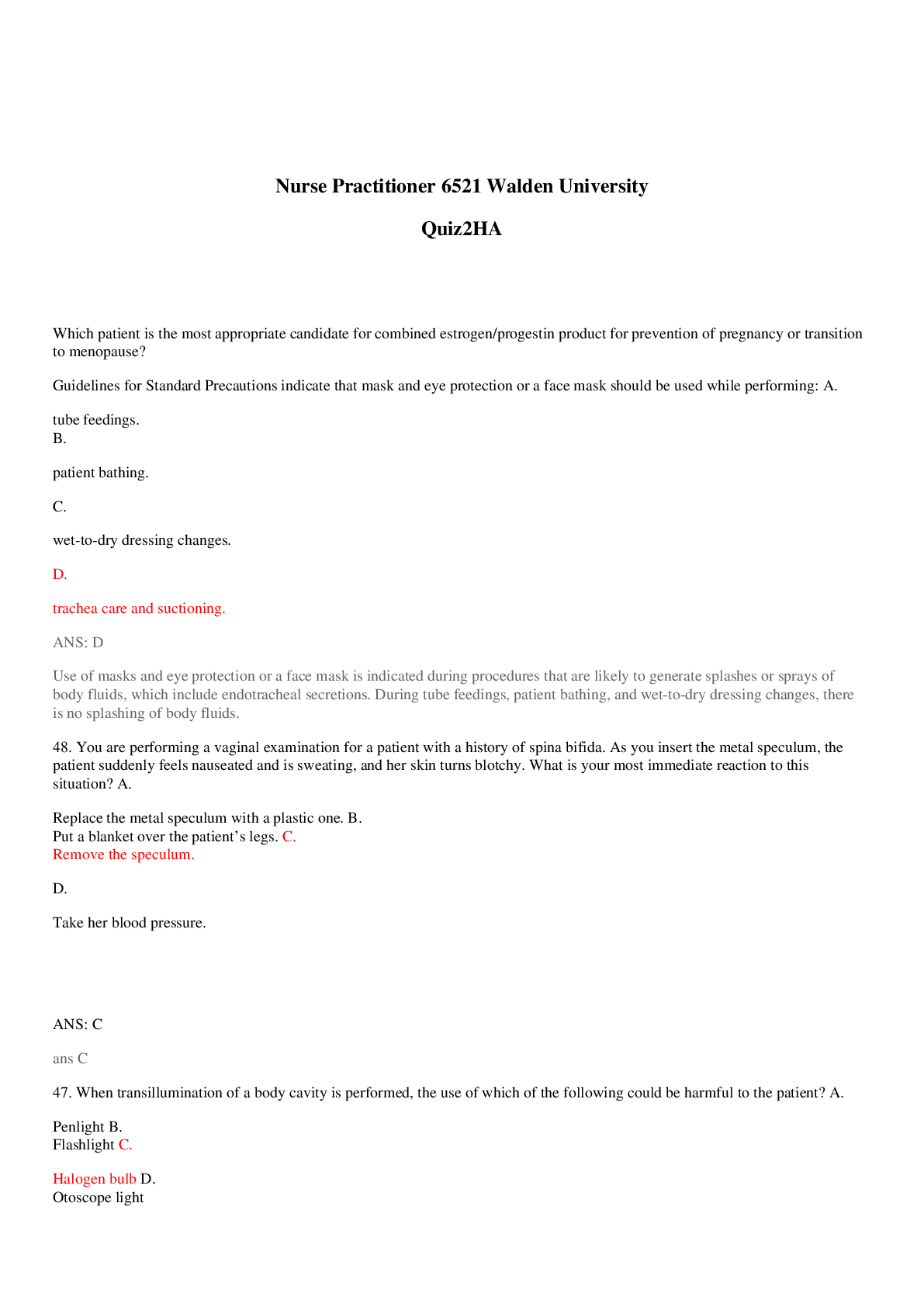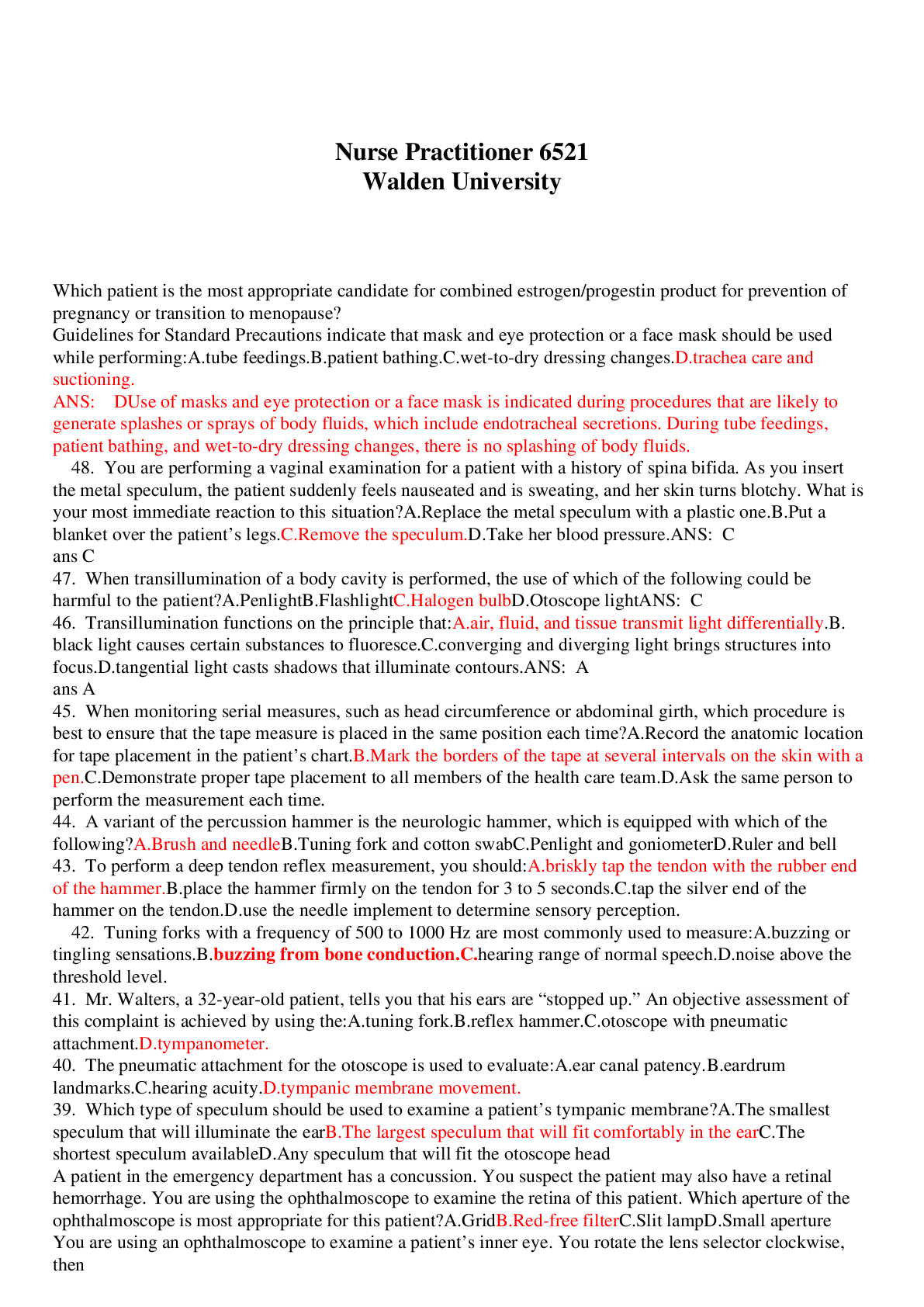EXAM #3 Study Guide:2022
Document Content and Description Below
EXAM #3 Study Guide:2022 Rectal/prostate exam position - knee-chest; lithotomy; left lateral with hips and knees flexed; or standing with the hips flexed leaning on exam table Rectal/prostate exam ... position males - left lateral with hips and knees flexed or standing with the thips flexed leaning on exam table Rectal/prostate exam position women - most often performed as part of the rectovaginal examination in the lithotomy position Rectal/prostate exam procedure - Lubricate index finger of gloved hand, press the pad against the anal opening, ask patient to bear down then slip tip into anal canal, ask to tighten sphincter noting tone, palpate for masses, nodules, irregularities, palpate lateral/posterior/anterior rectal walls, prostate (on anterior wall) Normal prostate exam - should feel like a pencil eraser— firm, smooth, and slightlymovable/nontender. Diameter of about 4 cm, with less than 1 cm protrusion into the rectum. Lobes should feel symmetric, seminal vesicles should not be palpable. Abnormal prostate exam - greater than 1 cm protrusion into rectum means enlargement, obliterated median sulcus means hypertrophied or neoplastic nodes, rubbery/boggy consistency means benign hypertrophy, stony/hard nodularity may mean carcinoma, prostatic calculi, chronic fibrosis, tender/fluctuant softness means prostatic abscess, palpable seminal vesicles means inflammation Extremely tight sphincter - scarring, spasticity from fissure or lesion, inflammation, anxiety Lax sphincter - neuro deficit or sexual abuse Rectal pain - anal fistula, anal fissure, perirectal abscess, thrombosed hemorrhoids Bidigital palpation - helpful for identifying perianal abscess, press thumb against anus while palpating with index finger Rectal prolapse findings - rectum starts to drop down, rectum partially protrudes, rectum fully protrudes; characterized by feeling of a bulge, bleeding, or pain Rectal prolapse causes - constipation, diarrhea, gynecologic surgery, pelvic neuropathies, or severe coughing/straining, age, nerve damage Hemorrhoid - varicose veins in lower rectum or anus, may be internal or external External hemorrhoids - may cause itching, bleeding, discomfort; invisible at rest, protrude on standing, straining; thrombosed are blue, shiny masses at anusInternal hemorrhoids - may have no symptoms, are soft swellings not palpable on rectal exam not visible unless prolapsed, dx w/ proctoscopy Rectal bleeding causes - anal fissures, anaphylactoid purpura, aspirin use, bleeding & coagulation disorders, colitis, dysentery, esophageal varices, familial telangiectasia, foreign body trauma, hemorrhoids, hiatal hernia, hookworm, intussusception, iron poisoning, Meckel diverticulum, neoplasms, oral steroids, peptic ulcers, polyps, regional enteritis, strangulated hernia, swallowed blood, thrombocytopenia, volvulus MS exam sequence - observe gait/posture as patient enters room, inspect (posture, deformities, symmetry, alignment, hypertrophy), palpate (bones, joints, tendons, muscles), evaluate ROM and muscle tone, muscle strength (hands, elbows, shoulders, TMJ, cervical/thoracic/lumbar spine ROM, hips, legs and knees, feet and ankles Limb measurement - asymmetry in limb size, normal is no more than 1 cm discrepancy in length and circumference; athletes w/ dominant arm may have greater discrepancy in circumferences Leg length - measured from the anterior superior iliac spine to the medial malleolus of the ankle, crossing the knee on the medial side Arm length - measured from the acromion process through the olecranon process to the distal ulnar prominence. Neer test identifies - shoulder rotator cuff impingement or tear Hawkins test identifies - shoulder rotator cuff impingement or tear Katz hand diagram - median nerve integrity Thumb abduction test - median nerve integrity; isolates strength of the abductor pollicis brevis muscle, innervated only by median nerve. Place the hand palm up and raise the thumb perpendicular to it. Apply downward pressure on the thumb to test muscle strength; full resistance to pressure is expected; weakness associated CTS Tinel sign - median nerve integrity; strike patient's wrist w/ index or middle finger where the median nerve passes under the flexor retinaculum and volar carpal ligament; tingling sensation radiating from the wrist to the hand in the distribution of the median nerve is positive, suggests CTS Phalen test - median nerve integrity; hold both wrists in a fully palmar-flexed position with the dorsal surfaces pressed together for 1 minute, numbness/tingling = CTS Reverse Phalen tests - hold hands together as if praying, press for 1 minuteLess likely CTS - Tinel and Phalen tests are ________ than Katz and Thumb test Straight leg raising - L4, L5, S1 nerve root irritation Femoral stretch test - L1, L2, L3, L4 nerve root irritation Ballottement and Bulge sign - effusion in the knee Ballottement - extend knee, push down on suprapatellar pouch with the web/thumb and forefinger of one hand, push the patella quickly downward against the femur with other hand; tapping or clicking will be sensed when the patella is pushed against the femur if effusion present. Release pressure and keep your finger lightly touching patella, patella will float out as if a fluid wave were pushing it if effusion present Bulge sign - knee extended, milk the medial aspect of the knee upward two or three times, and then milk the lateral side of the patella. Observe for a bulge of returning fluid to the hollow area medial to the patella McMurray test - supine, flex one knee, put thumb and fingers on either side of the joint space. Hold the heel with your other hand, fully flexing the knee, and rotate the foot and knee outward (valgus stress) to a lateral position. Extend and then flex the patient's knee. Any palpable or audible click, pain, or limited extension of the knee is a positive sign of a torn medial meniscus. Repeat while rotating the foot and knee inward (varus stress) A palpable or audible click, pain, or lack of extension is a positive sign of a torn lateral meniscus. Varus stress - McMurray, foot rotated in, sign of torn lateral meniscus Valgus stress - McMurray, foot rotated out, sign of torn medial meniscus Varus - abduction Valgus - adduction Anterior and posterior drawer test - ACL/PCL instability; supine, knee flexed 45 to 90 degrees, foot flat on the table. Place both hands on the lower leg with the thumbs on the ridge of the anterior tibia just distal to the tibial tuberosity. Draw the tibia forward, forcing the tibia to slide forward of the femur. Then push the tibia backward. Knee movement over 5 mm in either direction is an unexpected finding. Varus-valgus stress test - medial or lateral collateral ligament instability in knee Varus-valgus stress test how to - for lateral and medial collateral ligaments; pt supine, knee extended, stabilize femur with one hand, hold the ankle with other. Apply varus force against the ankle (toward the midline) and internal rotation. Excessive laxity is felt as joint opening = injury to the lateral collateral ligament. Repeat w/ valgus force (awayfrom midline/external rotation), laxity = injury to medial collateral ligament. Repeat w/ knee flexed to 30 degrees, excessive movement not expected. Lachman test - anterior cruciate ligament integrity; pt. supine, flex knee 10-15 degrees, heel on table. One hand above knee to stabilize femur, other around proximal tibia, pull tibia anteriorly while pt. relaxes hamstring; Increased laxity over 5 mm compared w/ uninjured side = ligament injury Thomas test - pt supine; fully extend one leg flat, other leg knee to the chest. Observe if pt can keep extended leg flat, if It lifts, = flexion contracture of hip of extended leg Trendelenburg sign - have patient stand and balance on one foot and then the other, note any asymmetry or change in the level of the iliac crests from behind; if iliac crest drops on the side of the lifted leg, this indicates the weak hip abductor muscles on weight-bearing side MS age-related changes - may need slower exam, increased dorsal kyphosis w/ flexion of the hips and knees; head may tilt backward d/t thoracic curvature, extremities may appear long d/t vertebral collapse, feet more widely spaced, arms away from the body to aid balancing; reduction in total muscle mass related to atrophy, Osteoarthritis risk factors - obesity female, family hx of osteoarthritis, hypermobility syndromes, age 40+, injury, high sports activities, peripheral neuropathy, job requiring joint overuse Osteoarthritis findings - pain (hands, feet, hips, knees, cervical/lumbar spine), onset after 40, nearly 100% of people over 75, develops slowly, brief morning stiffness, pain with use/relief with rest, enlarged joints d/t osteophytes, crepitus, limited, painful ROM, non-inflammatory effusion, no heat, tender joints, heberden nodes, bouchard nodes Rheumatoid findings - joint pain/stiffness, gradual onset, pain at rest, worse in morning and after inactivity, constitutional sx (severe fatigue, myalgias, weight loss, low-grade fever); involves hands, wrists, feet, ankles, hips, knees, cervical spine; synovitis w/ soft tissue swelling and effusions present on exam, nodes and deformities may develop, sometimes hot/red joint Carpal tunnel assessment - Katz hand diagram, thumb abduction test, Tinel sign, Phalen (all assess median nerve integrity) Carpal tunnel findings - numbness, burning, tingling or pain, often at night; associated with rheumatoid arthritis, gout, acromegaly, hypothyroidism, and pregnancy Plantar fasciitis special tests - Tinel test along distal tibial nerve to r/o tarsal tunnel syndrome, Calcaneus squeeze test to r/o calcaneal stress fracture.Plantar fasciitis findings - aching heel pain, worse w/ first step; better w/ activity, worse if prolonged Gout findings - Sudden onset, hot, swollen joint (usually proximal phalanx of great toe, also wrists, hands, knees) d/t monosodium urate crystals, exquisite pain; limited ROM, skin may be shiny red/purple, uric acid crystal tophi under skin when chronic; men over 40, postmenopausal women Meningitis assessment - Nuchal rigidity (pain/rigidity when neck flexed in supine position, possible swollen glands), Brudzinski's sign (involuntary hip flexion when neck flexed), Kernig sign (flex knee at hip when supine, attempt to straighten leg, positive if pain in lower back and resistance to straightening) Jolt accentuation of headache - if fever/headache when meningitis suspected, pt rotate head horizontally 2-3 times per second, increased headache over baseline positive Meningitis findings - fever, stiff neck, and AMS; also headache, rash, nausea, vomiting, chills, and myalgia. Nuchal rigidity, Brudzinski sign, and Kernig sign are diagnostic signs Spinal stenosis signs - pain in buttocks/down legs w/ walking, standing; worsened w/ prolonged standing, walking, back hyperextension; pain relieved by bending forward; normal early neuro exam, later lower extremity weakness, sensory loss, may be stooped forward OA - Insidious, over many years, few minutes of a.m. stiffness, pain on motion/w prolonged activity, mild/localized weakness, fatigue is rare, depression/emotional unusual, localized tenderness, non-inflammatory effusion common/little synovial reaction, rare heat/effusion, course to medium crepitus on motion, mild joint enlargement/bony consistency d/t osteophytes, heberden's and bouchard's nodes RA - Gradual (typically weeks to months), sometimes 24-48 hours, several hours a.m. stiffness, pain at rest, pronounced weakness, severe fatigue 4-5 hours after waking, depression/emotional common, almost always tender/most sensitive indicator of inflammation, fusiform soft tissue enlargement, inflammatory effusion common, synovial proliferation/thickening, often symmetric, nodules; sometimes heat/effusion, medium to find crepitus, moderate to severe joint enlargement if effusion present, ulnar deviation, swan neck deformity, bouttoneire deformity Rheumatoid - deviation of fingers to ulnar side, swan neck and boutonnière deformities, spindle-shaped fingers DDx for red, hot joint - septic arthritis, gonococcal arthritis, gout and pseudogout, and systemic rheumatic disease manifesting in only one joint (RA, Lyme arthritis) Neer test - forward flex arm up to 150 degrees while depressing the scapula. Increased shoulder pain is associated with rotator cuff inflammation or a tearShoulder assessment - CN X1 accessory (shoulder shrug, Neer, Hawkins) Hawkins test - abduct shoulder to 90 degrees, flexing the elbow to 90 degrees, and then internally rotating the arm to its limit. Increased shoulder pain is associated with rotator cuff inflammation or a tear ROM positions - abduction, adduction, supination, pronation, extension, flexion Abduction - toward body Adduction - away from body Supination - lying face up or ankle rolled out Pronation - lying face down or ankle rolled in Extension - extended out straight Flexion - bent (knee, elbow) Sports physical history - history of exertional symptoms (e.g., chest pain, dyspnea), known heart murmur, unexplained syncope or near-syncope, symptoms of Marfan syndrome, family hx of premature heart conditions or sudden death. Sudden death sports - premature heart conditions, blunt chest and head trauma, drug abuse, asthma, heat stroke, and drowning 14-step MS sports examination - eval positions/postures for asymmetries in ROM, strength, muscle bulk Sports physical components - H&P for neuro, cards, resp, vision, ortho, psych, abdominal, GU, derm Functional assessment of OA - sitting balance, arises, attempts to arise, immediate standing balance, standing balance, score less than 21 indicates high risk for falls Pediatric MS assessment - sitting, fetal, suspended. Kids may be observed playing. Barlow-Ortolani maneuver - IDs hip dislocation or subluxation, all exams to age 1. Using little force, test one hip at a time, stabilizing the pelvis with the other hand. By 3 months of age, muscles and ligaments tighten, and limited abduction of the hips becomes the most reliable sign of hip subluxation or dislocation Barlow - infant supine, flex the hip and knee to 90 degrees; grasp the leg , adduct thigh and gently apply downward pressure on the femur in an attempt to disengage thefemoral head from the acetabulum. A positive sign is when a clunk or sensation is felt as femoral head exits the acetabulum posteriorly. Ortolani maneuver - slowly abduct thigh while maintaining axial pressure. With the fingertips on the greater trochanter, exert a lever movement in the opposite direction so that your fingertips press the head of the femur back toward the acetabulum center. If the head of the femur slips back into the acetabulum with a palpable clunk when pressure is exerted, suspect hip subluxation or dislocation. High-pitched clicks are common/expected. Allis sign - detects hip dislocation or shortened femur. Supine infant, flex both knees, keeping the feet flat on the table close to the buttocks and the femurs aligned with each other. Observe knee height, if one higher, sign is positive. Neuro exam sequence - Cranial nerves II through XII (only test taste if problem), Proprioception and Cerebellar Function (rapid rhythmic alternating movements, accuracy of movements, balance (Romberg test is given), and gait and heel-toe walking), Sensory Function (superficial pain and touch at a distal point in each extremity are tested; vibration and position senses are assessed by testing the great toe), Deep Tendon Reflexes (all except plantar reflex and the test for clonus) Normal neuro changes OA - decreased salty taste, diminished hearing/vision, reduced tactile and temperature sensation, decreased touch perception and manual dexterity, reduced balance, strength, proprioception; shuffling gait, Tactile, vibratory, position sense may be reduced; DTRs become less brisk or absent (LE before UE), achilles and tendon DTR may be absent or diminished, superficial reflexes may disappear; development of benign essential tremor normal, fine motor coordination and agility may be impaired Tinetti Balance and Gait Assessment Tool - used for mobility assessment, falls risk assessment Parkinson disease - Tremors, muscular rigidity, cogwheel rigidity with jerks, stooped posture, balance and postural instability, short steps, shuffling, freezing gait, gait may accelerate to maintain upright posture, slow, slurred monotonous speech, voice softening, impaired cognition, dementia Dermatome levels - cervical, thoracic, sacral, lumbar C3 Dermatome - Lateral Neck C4 Dermatome - Over Clavicle C5 Dermatome - Lateral upper arm near deltoid insertion C6 Dermatome - thumb and lateral forearmC7 Dermatome - Middle finger C8 Dermatome - Medial border of hand, little finger T1 Dermatome - Medial forearm T2 Dermatome - Medial upper arm close to axilla L1 Dermatome - Anterior groin L2 Dermatome - Middle to upper anterior thigh L3 Dermatome - Middle to lower medial thigh L4 Dermatome - Medial aspect of foot to great toe L5 Dermatome - Central dorsum of foot to middle toe S1 Dermatome - Lateral aspect of foot and lateral posterior thigh S2 Dermatome - Medial of posterior thigh S3 Dermatome - Groin, medial thigh to knee Rectal prolapse - Protruding rectal mucosa. Thick concentric mucosal ring. Sulcus noted between anal canal and rectum. MS exam sequence - inspect, palpate, range of motion, muscle tone, muscle strength Stereognosis - hold familiar object with eyes closed, identify it MS changes OA - bone loss, boney prominences more apparent, deteriorating cartilage around joints, tendon less elastic, reduced total muscle mass, tone and strength, decrease in reaction time, speed of movement, agility and endurance occur Tactile agnosia - inability to identify objects by touch, suggests parietal lobe lesion Graphesthesia - draw letter or number on hand, ask pt to identify figure Vibratory - touch bony prominence (usually toe or finger) w/ tuning fork, as them when/where it is felt 2-point discrimination - touch pt with 1 or 2 ends of paperclip at same time, ask how many points they feelProprioception - recognition of body parts and awareness of position (ask if toe/finger is up or down, rapid alternating movements - on lap, finger to finger, finger to nose) Proprioception examination - Romberg test, heel-to-toe walking, standing on one foot and then on the other with eyes closed, hopping in place, and deep knee bends. Equilibrium - perform Romberg test - Ask the patient (with eyes open and then closed) to stand, feet together and arms at the sides, slight swaying is expected, but not almost falling. Nudge standing patient, should recover/not fall. Stand on 1 foot (5 seconds), Hop on 1 foot (5 seconds). Positive Romberg sign - loss of balance, indicates cerebellar ataxia, vestibular dysfunction, or sensory loss. If this happens, postpone other tests of cerebellar function requiring balance. Straight leg raising test - test for nerve root irritation or lumbar disk herniation (L4, L5, and S1 levels). Supine w/ neck slightly flexed, ask to raise leg w/ knee extended; no pain should be felt below knee; radicular pain below knee may = disk herniation. Crossover pain in the affected leg may indicate sciatic nerve impingements. Tendons - attach muscle to bone Ligaments - attach bone to bone Upper abdominal - superficial - T8, T9, and T10 Lower abdominal - superficial - T10, T11, and T12 Cremasteric - superficial - T12, L1, and L2 Plantar - superficial - L5, S1, and S2 Biceps - DTR - C5 and C6 Brachioradial - DTR - C5 and C6 Triceps - DTR - C6, C7, and C8 Patellar - DTR - L2, L3, and L4 Achilles - DTR - S1 and S2 DTR Grades - 0 No response, 1 + Sluggish or diminished, 2 + Active or expected response, 3 + More brisk than expected, slightly hyperactive, 4 + Brisk, hyperactive, with intermittent or transient clonusMuscle strength Grade 1: - Trace of contraction, but no movement at the joint. Muscle strength Grade 2: - Movement at the joint with gravity eliminated. Muscle strength Grade 3: - Movement against gravity, but not against added resistance. Muscle strength Grade 4: - Movement against external resistance with less strength than usual. Goniometer - assesses ROM Scoliosis findings - noticeable lateral curvature of the spine, or rib hump, as the patient bends forward at the waist, waist crease, leg length discrepancy, S or C curve Scoliometer reading - 7+ is positive at any level of spine Babinski sign - present when dorsiflexion of the great toe with or without fanning of other toes, indicates pyramidal tract upper motor neuron disorder, expected in children younger than 2 Dementia - onset insidious, persistent, stable all day, consciousness not impaired, minimal cognitive impairment initially, progresses to impaired abstract thinking, judgment, memory, thought patterns, calculations, agnosia; no change in activity, disordered, rambling, incoherent speech, depressed/apathetic mood, delusions, no hallucinations, irreversible, r/t brain diseases Delirium - acute onset (hours to days), fluctuates throughout day, altered consciousness, impaired memory, attentiveness, increased or decreased activity, rambling, irrelevant conversation/may fluctuate, rapid mood swings, fearful/suspicious, illusions/delusions/hallucinations present, may be reversed, acute onset r/t inflammation, electrolyte imbalance Parkinson - tremors at rest, muscular rigidity, cogwheel rigidity with jerks, stooped posture, balance and postural instability, short steps, shuffling, freezing gait, gait may accelerate to maintain upright position, slow slurred monotonous speech, voice softening, impaired cognition, dementia; Classic features: excessive sweating, drooling with excess saliva, gait with rapid, shuffling steps and reduced arm swinging MS findings - muscle weakness, ataxia, hyperactive deep tendon reflexes, paresthesia, sensory loss, intention tremor, optic neuritis, cognitive changes, MRI reveals brain lesions Normal gait of OA - shorter steps with less lifting of the feet, shuffling may occur as speed, balance, and grace decrease. Arms are more flexed, and legs may be flexed at the hips and kneesRooting - at birth, gone 3-4 mos. Palmar grasp - birth, strongest 1-2 mos., gone by 3 Plantar grasp - birth, strong until 8 mos. Moro - birth, diminished 3-4 mos., gone by 6; semisitting position, allow the head and trunk to drop back to a 30-degree angle; observe symmetric abduction and extension of the arms; fingers fan out and thumb and index finger form a C; the arms then adduct in an embracing motion followed by relaxed flexion; the legs may react similarly Placing - 3-4 days, variable disappearance. Hold the infant upright under the arms next to a table or chair; touch the dorsal side of the foot to the table or chair edge; observe flexion of the hips and knees and lifting of the foot as if stepping up on the table Stepping - birth, gone before voluntary walking; infant 'steps' when feet on flat surface Fencing - 2-3 mos., dim by 3-4, gone by 6. Arm extends toward side child is facing Comprehensive exam sequence - measurements, head/face, eyes, ears, nose, mouth/pharynx, neck, UE, back/posterior chest & lungs, anterior chest/lungs/heart, breasts, abdomen, inguinal, male genitals, feet/legs, hips, musculoskeltal, neuro, spine, abdominal/hernia, gyne exam, Clinical judgment - assess what you learn of patient, gather info; identify problem, presume diagnosis; identify tests/procedures/studies Sensitivity - ability of an observation to identify correctly those who have a disease Specificity - ability of an observation to identify correctly those who do not have a disease True positive - expected observation that is found when the disease characterized by that observation is present True negative - an expected observation that is not found when the disease characterized by that observation is not present False positive - an observation made that suggests a disease when that disease is not present False negative - an observation that suggests a disease is not present when in fact it is (e.g., absence of cough or respiratory findings when lung cancer is present)Positive predictive value - proportion of persons with an observation characteristic of a disease who have it (observation is made 100 times, 95 of those occasions that observation proves to be consistent with the ultimate diagnosis, ___ is 95%) Negative predictive value - proportion of persons with an expected observation who ultimately prove not to have the expected condition (100 observations are made expecting a disease, 95 times that observation is not found and the condition proves not to have dx, NPV is 95% Emergencies - Rapid primary assessment, secondary assessment, definitive care Life threatening situations - Airway obstruction, impaired ventilation and hypoxemia, hypovolemic shock, hemorrhage; manage as soon as detected, repeat Q5m ABCDE for ER - Airway is maintained and cervical spine control, Breathing assessed, Circulation assessed/hemorrhage controlled, Disability assessed w/ patient's degree of responsiveness, Exposure - undress to ID all injuries, maintain body temp Secondary ER - in-depth exam for anatomic problems, additional potentially lifethreatening conditions, patient's previously diagnosed conditions; Check VS before beginning HTT exam SAMPLE abbreviated history - symptoms, allergies, current meds, past illnesses, last meal, events preceding incident Secondary ER exam - head/neck, chest, abdomen, extremities/back, rectum/perineum, neuro exam, reevaluation SER exam head/neck - inspect/palpate head/scalp for depressions, bone instability, crepitus, lacs, penetrating injuries, ear/nose drainage; examine eyes for pupil size/light response, retina/conjunctivae for hemorrhage, lens for dislocation, EOMs; ears inspect TMs for blood in middle ear w/ otoscope; assess face for factures (racoon eyes, battle sign); inspect neck for penetrating injuries, bruising, trachea deviation from midline; palpate for deformity/crepitus, auscultate carotids for bruits, maintain neck in neutral position until Xrays confirm no cervical injury SER exam chest - Inspect anterior/posterior for bruises, obvious deformity; palpate sternum, ribs, clavicle, auscultate breath sounds at apex, base, midaxillary, auscultate heart for clarity of HS, chest Xrays SER exam abdomen - inspect the abdomen for bruising/distention, gently palpate noting guarding/pain (hollow organs may rupture w/ blunt trauma), peritoneal lavage or Xrays may be performed SER exam extremities - inspect and palpate for fractures, deformities, crepitus, pain, lack of spontaneous movement, palpate peripheral pulses, inspect back, inspect forbruising and palpate for pelvic fractures, inspect perineum for bruising, lacs, urethral bleeding, rectal and/or vaginal exam if needed Log-roll - perform to inspect back SER exam neuro - Total neuro exam performed after stabilized; Reassess GCS, pupil size/reactivity, detailed motor and sensory eval noting paralysis or paresis, Reevaluation - reevaluate frequently for new S&S, perform primary survey Q5m to compare, monitor VS, LOC, maintain suspicion for early recognition/mgmt. Acute med emergencies - Black/dark brown coffee grounds emesis Upper GI bleed - coffee grounds emesis Myocardial infarction - crushing pain in center of chest Acute glaucoma - severe throbbing pain in/around a bloodshot eye Retinal detachment - flashes of light in the field of vision of one eye Acute abdomen - sudden and progressively severe abdominal pain TIA/stroke - sudden weakness and unsteadiness possible momentary LOC Pulmonary edema - sudden onset of difficulty breathing (often in the middle of the night) and worsens rapidly Injury Assessment - history of injury, ID mechanism determine severity Injury mechanism - nature/force of energy, associated with injury patterns Blunt trauma - MVC (most often), falls, struck by object, recreational/sports activities Penetrating trauma - GSW, stabbings, impalement Determine injury type & management - region of body/organs in path of penetrating object, transfer of energy determined by force of impact (velocity of object, caliber, distance from source) Burns - possible airway inflammation d/t smoke, heat, toxic chemical inhalation, CO poisoning Patent airway - crying or talking child currently has aAVPU level of responsiveness assessment - helpful for children and adults - Alert, Verbal stimuli (responsive to), Painful stimuli (responsive to), Unresponsive Where does it hurt? - Assess child Child approx. expected BP - 80 + 2x child's age in years Over 2 seconds - abnormal capillary refill time for children and adults Large relative BSA - exposure for assessment = significant heat loss ER history taking for child - SAMPLE abbreviated history symptoms, allergies, current meds, past illnesses, last meal, events preceding incident PLUS pregnancy/delivery info Weight - get for calculating resuscitation medication dosages and fluid volumes OA aspiration/obstruction risk - muscles in the upper airway weaken with age. OA decreased vital capacity - ventilatory function may be less efficient. OA cardiovascular changes - decrease in HR and cardiac output, increased risk of CAD, arrhythmias OA BP - increases with age, vasculature becomes stiff, less able to compensate quickly for low perfusion states OA peripheral pulses - may be difficult to palpate, vascular changes, poor circulation OA Beta blockers - unable to compensate and increase their heart rate in cases of shock or dehydration OA anticoagulation therapy - experience increased bleeding OA pain perception - may be reduced d/t deterioration of nerve endings OA mental status - chronic MS changes may be present OA skin - thinner sub-q fat, injures easily, hypothermia greater risk, Meticulous record-keeping - essential bc memory is unreliable, record obs/evals/orders/what was done/not done, must be thorough, concise, clear, and accurate, chronological events, legible Life-threatening situations - treat first, consent later whenForensic trauma - preserve evidence - save bullets/clothing for LE w/ documented chain of possession by healthcare professionals Advance Directives - formal statement of desired medical care in the event of a catastrophic injury or illness, make conscientious effort to learn if they have one, important if cognitive impairment preventing medical decision making Living wills - formally IDs conditions where specific medical interventions desired, utilized, limited, or forbidden if unable to make decisions DPOA for healthcare - delegates a close relative/trusted person to make health care decisions when the patient is unable to make health care decisions Upper airway obstruction - compromise of the airway space, resulting in impaired respiratory exchange Hypoxemia - severely reduced blood oxygen levels in major organs Ventilatory failure - compromised exhalation of carbon dioxide because of alveolar hypoventilation Shock state - abnormality of the circulatory system that results in inadequate organ perfusion and tissue oxygenation (hypovolemic, septic, spinal cord injury, injury above diaphragm e.g. myocardial contusion, tension pneumothorax) Increased intracranial pressure - increase in volume of brain tissue, blood, or cerebrospinal fluid (CSF) within the closed space of the skull that results in elevated pressure Pulmonary embolism - migration of a blood clot from the deep veins of the legs or pelvis to the lung vasculature Status asthmaticus - zcute severe asthma exacerbation that does not respond to usual treatment Status epilepticus - prolonged seizure or series of seizures that occur without recovery of consciousness Medulla oblongata CN IX to XII - Respiratory, circulatory, and vasomotor activities; houses respiratory center Reflexes of swallowing, coughing, vomiting, sneezing, and hiccupping Relay center for major ascending and descending spinal tracts that decussate at the pyramid Pons CN V to VIII - Reflexes of pupillary action and eye movement Regulates respiration; houses a portion of the respiratory center Controls voluntary muscle action with corticospinal tract pathwayMidbrain CN III and IV - Reflex center for eye and head movement Auditory relay pathway Corticospinal tract pathway Diencephalon CN I and II - Thalamus Relays impulses between cerebrum, cerebellum, pons, and medulla Conveys all sensory impulses (except olfaction) to and from cerebrum before their distribution to appropriate associative sensory areas Integrates impulses between motor cortex and cerebrum, influencing voluntary movements and motor response Controls state of consciousness, conscious perceptions of sensations, and abstract feelings Epithalamus - Houses the pineal body Sexual development and behavior Hypothalamus - Major processing center of internal stimuli for autonomic nervous system Maintains temperature control, water metabolism, body fluid osmolarity, feeding behavior, and neuroendocrine activity Pituitary gland - Hormonal control of growth, lactation, vasoconstriction, and metabolism Olfactory (I) - Sensory: smell reception and interpretation Optic (II) - Sensory: visual acuity and visual fields Oculomotor (III) - Motor: raise eyelids, most extraocular movements Parasympathetic: pupillary constriction, change lens shape Trochlear (IV) - Motor: downward, inward eye movement Trigeminal (V) - Motor: jaw opening and clenching, chewing, and mastication Sensory: sensation to cornea, iris, lacrimal glands, conjunctiva, eyelids, forehead, nose, nasal and mouth mucosa, teeth, tongue, ear, facial skin Abducens (VI) - Motor: lateral eye movement Facial (VII) - Motor: movement of facial expression muscles except jaw, close eyelids, labial speech sounds (b, m, w, and rounded vowels) Sensory: taste— anterior two-thirds of tongue, sensation to pharynx Parasympathetic: secretion of saliva and tears Acoustic (VIII) - Sensory: hearing and equilibrium Glossopharyngeal (IX) - Motor: voluntary muscles for swallowing and phonation (guttural speech sounds) Sensory: sensation of nasopharynx, gag reflex, taste— posterior one-third of tongue Parasympathetic: secretion of salivary glands, carotid reflexVagus (X) - Sensory: sensation behind ear and part of external ear canal Parasympathetic: secretion of digestive enzymes; peristalsis; carotid reflex; involuntary action of heart, lungs, and digestive tract Spinal accessory (XI) - Motor: turn head, shrug shoulders, some actions for phonation Hypoglossal (XII) - Motor: tongue movement for speech sound articulation (l, t, d, n) and swallowing Ascending spinal tracts - (e.g., spinothalamic, spinocerebellar) mediate various sensations; manage sensory signals necessary for complex discrimination tasks. Posterior (dorsal) column spinal tract - (fasciculus gracilis and fasciculus cuneatus) - fine touch, two-point discrimination, and proprioception. Spinothalamic - light and crude touch, pressure, temperature, and pain. Descending spinal tracts - (corticospinal, reticulospinal, vestibulospinal) convey impulses from brain to muscle groups by inhibiting or exciting spinal activity. Also help control muscle tone, posture, and precise motor movements. Corticospinal (pyramidal) tract - skilled, delicate, and purposeful movements. Vestibulospinal tract - causes the extensor muscles of the body to suddenly contract when an individual starts to fall. Corticobulbar tract arising from the brainstem - innervates motor functions of the cranial nerves. Upper motor neurons - nerve cell bodies for the motor pathways that all begin and end within the central nervous system. Include descending pathways from brain to spinal cord. Influence, direct, and modify spinal reflex arcs and circuits. Upper motor neurons - affect movement only through the lower motor neurons. Lower motor neurons, cranial and spinal motor neurons - originate in the anterior horn of the spinal cord and extend into the peripheral nervous system; Transmit neural signals directly to the muscles to permit movement. Upper motor neurons - injury to _________results in initial paralysis followed by partial recovery over an extended period. Lower motor neurons - injury often results in permanent paralysis. Afferent - sensoryEfferent - motor CN I (olfactory) - Test ability to identify familiar aromatic odors, one naris at a time with eyes closed CN II (optic) - Test distant and near vision Perform ophthalmoscopic examination of fundi; Test visual fields by confrontation and extinction of vision CN III (oculomotor), CN IV (trochlear), and CN VI (abducens) - Inspect eyelids for drooping Inspect pupils' size for equality and their direct and consensual response to light and accommodation. Test extraocular eye movements CN V (trigeminal) - Inspect face for muscle atrophy and tremors, Palpate jaw muscles for tone and strength when patient clenches teeth, Test superficial pain and touch sensation in each branch (test temperature sensation if there are unexpected findings to pain or touch), Test corneal reflex CN VII (facial) - Inspect symmetry of facial features with various expressions (e.g., smile, frown, puffed cheeks, wrinkled forehead), Test ability to identify sweet and salty tastes on each side of tongue CN VIII (acoustic) - Test sense of hearing with whisper screening tests or by audiometry, Compare bone and air conduction of sound, Test for lateralization of sound CN IX (glossopharyngeal), and X (vagus) - Test ability to identify sour and bitter tastes on each side of tongue, Test gag reflex and ability to swallow Inspect palate and uvula for symmetry with speech sounds and gag reflex, Observe for swallowing difficulty, Evaluate quality of guttural speech sounds (presence of nasal or hoarse quality to voice) CN XI (spinal accessory) - Test trapezius muscle strength (shrug shoulders against resistance), Test sternocleidomastoid muscle strength (turn head to each side against resistance) CN XII (hypoglossal) - Inspect tongue in mouth and while protruded for symmetry, tremors, and atrophy, Inspect tongue movement toward nose and chin, Test tongue strength with index finger when tongue is pressed against cheek, Evaluate quality of lingual speech sounds (l, t, d, n) Sensory (S), Motor (M), or Both (B) - Some Say Marry Money But My Brother Says Bad Business Marry Money Migraine hx findings - starts in childhood, unilateral or generalized, hours to days, prodromes - vague neurologic changes, personality change, fluid retention, appetite loss to well-defined neurologic event, scotoma, aphasia, hemianopsia, aura, precip events - females, period, bcp, following stress, can cause nausea/vomiting,Tension headache hx findings - adulthood, uni- or bilateral, hours to days, any time, bandlike/constricting, prodromes - none, precip - anger, bruxism, stress, daily, male or female Cluster headache hx findings - adulthood, unilateral, .5 to 2 hours, night, intense/boring/searing/knifelike, prodromes - personality changes, ETOH use, several x nightly, several days, then none, males, tearing/nasal discharge [Show More]
Last updated: 1 year ago
Preview 1 out of 19 pages
Instant download

Buy this document to get the full access instantly
Instant Download Access after purchase
Add to cartInstant download
Reviews( 0 )
Document information
Connected school, study & course
About the document
Uploaded On
Apr 29, 2022
Number of pages
19
Written in
Additional information
This document has been written for:
Uploaded
Apr 29, 2022
Downloads
0
Views
52

